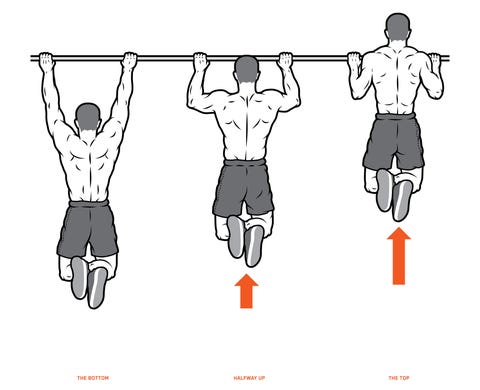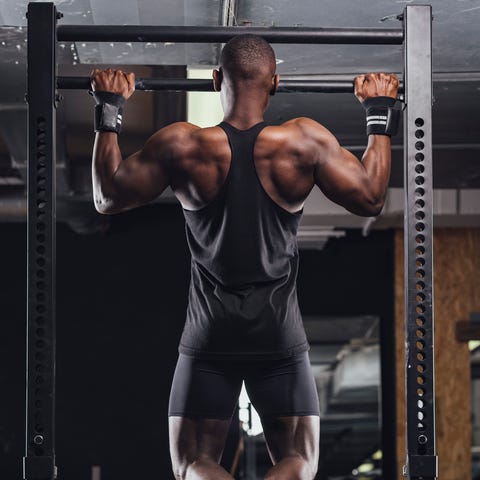Your Ultimate Guide To Pullups
Do you avoid the pullup bar? Have flashbacks of gym class humiliation? You’re not alone. The pullup remains daunting for plenty of guys. And that’s too bad, because few exercises can strengthen your entire upper body, challenge your core, and improve your posture the way the classic pullup can.
Learning this move is a challenge worth undertaking, no matter your fitness goals. It’s one of the fundamental building block exercises in the gym, beneficial for CrossFitters, bodybuilders, and general fitness enthusiasts alike. This is an exercise you can do anywhere, from your gym’s pullup bar to city construction scaffolding, to the sturdy tree branch in your backyard. It’s also a move that focuses in on a part of your body that you want to train aggressively: Your back. Strong back muscles help protect your shoulders from injury, and they help position your body to get more out of other exercises (everything from bench presses to biceps curls), too.
Thing is, pullups aren’t easy to learn, for a variety of reasons. First, there’s shoulder mobility, an area that’s a struggle for many people. Second? You’re lifting a large percentage of your bodyweight, and that’s simply not easy. The move also has multiple schools of thought these days, making it that much more confounding to understand from the ground up.
We’re here to show you the way. Whatever challenges stand in the way of your pullup success, we’ll help you fight past them so you can master the pullup, one of the gold standard’s of bodyweight exercise. And if you’re still haunted gym class nightmares, you’ll learn new ways to raise your game. It’s time to step up to the bar.
First, Let’s Learn the Details Of A Rep
Doing a pullup requires more than just hanging from a bar and pulling until your chin is above it. Knowing the nuances will keep your shoulders healthy as you strengthen your back. You can think of the pullup in three different phases: The start from the bottom, the position halfway up, and the top position, where you need to find a way to keep on pulling.
ISM
Start At The Bottom
Never let the tension leave your back. Your arms should straighten fully, but don’t just hang. Maintain constant tension across your shoulder girdles–the muscles around your shoulder blades and collarbone. The “dead hang” position–letting your shoulders shrug up to your ears–places strain on your biceps tendons and rotator cuffs, explains Eric Cressey, C.S.C.S., of Cressey Sports Performance in Massachusetts. You don’t want that.
Halfway Up, Shift Your Focus
Pay attention to your shoulder blades. Once you start pulling up, don’t use your arms alone. Instead, think about pulling your shoulder blades down and back as your elbows travel toward your ribs. You’re controlling your shoulders and shoulder blades using what physiologists call “scapulo-humeral rhythm,” says Jeff Cavaliere, C.S.C.S., a physical therapist and founder of the Athlean-X training program. This is key to shoulder health and pullup dominance.
At the Top? Don’t Quit Now.
Work to finish the rep. When your chin clears the top of the bar, don’t stop pulling. Squeeze your shoulder blades back and try to make and hold a double chin. Think about continuing to pull upwards, even if you’re not getting any higher. As you’re doing this, try to maintain tension in your abs and glutes. Your torso might lean slightly backward so your hips and feet are in front of the bar. That’s not a problem, but you shouldn’t let your shoulders jut forward of the bar, Cressey says. That could set you up for a rotator cuff injury.
The Great Pullup Debate
Westend61Getty Images
There are three main styles of pullup you’ll see done in the gym. There’s the true dead-hang pullup, where you lower your torso until your arms are fully hanging, then pull up as high as you can. There’s the constant-tension pullup often favored by bodybuilders, where you lower almost to the bottom but not quite, then immediately begin your next rep. Finally, there’s the kipping pullup, favored by CrossFitters, where you swing your hips back and forth to generate momentum and help drive your chest up to the bar.
What’s the best version? Depends on your goal, and the health of your shoulders.
Dead-Hang Pullup
At the bottom of the pullup, you fully relax all your shoulder and back muscles, and pause. From there, you pull up.
Pros: You’re using a full range of motion, which means you get a good stretch on all your back muscles. The pause minimizes cheating.
Cons: You’re leaving your shoulder ligaments vulnerable to strains.
Constant-Tension
This is the gold standard pullup; you maintain tension in your back at the bottom. The key to getting the most out of this: Don’t lower down only halfway in the name of “constant tension.” Your elbows should be nearly straight in the bottom position, and your shoulders should be almost-but-not-quite relaxed.
Pros: You get to strengthen your back and arms while keeping your shoulder ligaments safe.
Cons: The move is far harder than it looks; eight good constant-tension pullups can challenge most fit guys.
Kipping Pullup
A version in which your hips (and, as a result, your shoulders) swing forward and snap back, building momentum to propel you upward.
Pros: This one will challenge your endurance while still helping you develop upper-body strength. Pullups are inherently challenging, so most people can’t do, say, 20 reps. By adding in a kip however, they can push those rep loads much higher.
Cons: If your shoulder stability isn’t flawless, you’ll easily hurt your shoulders. Think twice before doing this. You should have a mastery of the constant-tension and dead-hang pullups before you venture into this territory.
The Ultimate Pullup Progression
Very few people can jump onto a bar and instantly do plenty of pullups without serious practice. Again, the move is challenging; it’s not easy to hoist your bodyweight upwards rep after rep.
But once you master the basic pullup, there are plenty of tricks and experiments you can try. Master the basic progression in the video below, and then play with the pullup ideas that follow, some of which can help you towards the pullup — and some of which will challenge you endlessly.
Just learning? Do these moves three times a week.
Static Hold: Stand on a box beneath your pullup bar and jump to the top position of the pullup. Hold there for as long as you can, squeezing your back muscles. Aim for three 20-second holds.
Negative Pullup: Stand on a box beneath the bar and jump to the top position. Hold for just a moment; then slowly lower yourself. This lowering process should take 5 seconds. Do 3 sets of 5 like this.
Inverted Row: Grab a bar set up above you and lean back so your torso is nearly parallel with the floor. Pull your elbows backward and return to the start. That’s 1 rep. Do 3 sets of 15. No, this doesn’t seem like a pullup variation, but it’s building the horizontal pullup strength that you need as a base for pullups. Need more on the inverted row? Check out the video below.
Got those basics? Do these moves twice a week.
Low-Rep Drill: Hang, do 1 pullup, and let go of the bar, landing on the floor. Do 5 of these your first week. The next week, do 4 sets of 2 reps (in other words, 2 pullups before you release and land).
Assisted Pullup: Hang a resistance band over the bar; pull the shorter loop through the longer one. Place your feet on the bottom loop. Hang from the bar and do pullups. Aim for 2 sets of 8 reps.
Scapular Pullup: Hang from a bar with your shoulder blades slightly tightened. With your arms straight, squeeze your shoulder blades; hold 1 second. That’s 1 rep; do 2 sets of 10 to 15 reps.
Ready for a challenge? Take these on.
Weighted Pullup: Forget adding reps–it’s resistance that gets you strong. Ideally, you should wear a vest and do 3 sets of 10 before adding more resistance. No vest? Use a weight plate (shown).
Mixed Grip Pullup: This one’s functional: Grip the bar with one hand overhand and the other underhand. Now do pullup reps, fighting to stay balanced; don’t let your hips shift to one side or the other.
Plyo Pullup: Pull yourself up quickly, and as your chin nears the bar, let go of the bar for a moment; then grab it again. Too easy? Try this: When you let go, catch the bar using an underhand grip.
Rope Pullup: Pullups always challenge your grip, but this variation ups the forearm ante. Hang a thick rope over the bar and do pullups while holding on to the rope with each hand.
L-Sit Pullup: In the bottom position, squeeze your legs together and extend them forward, forming an L with your torso. Keep your core tight and hold this position as you do pullup reps.
Marija JovovicGetty Images
Archer Pullup: As you pull yourself up, pull your chest toward your left hand, straightening your right arm as your chest nears the bar. Lower, pause, then repeat, pulling yourself toward your right hand.
Source: Read Full Article


